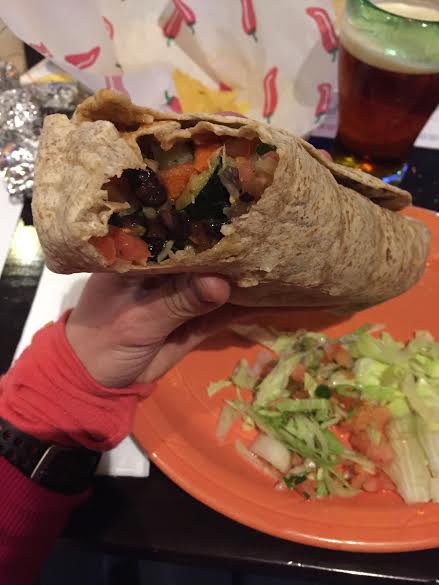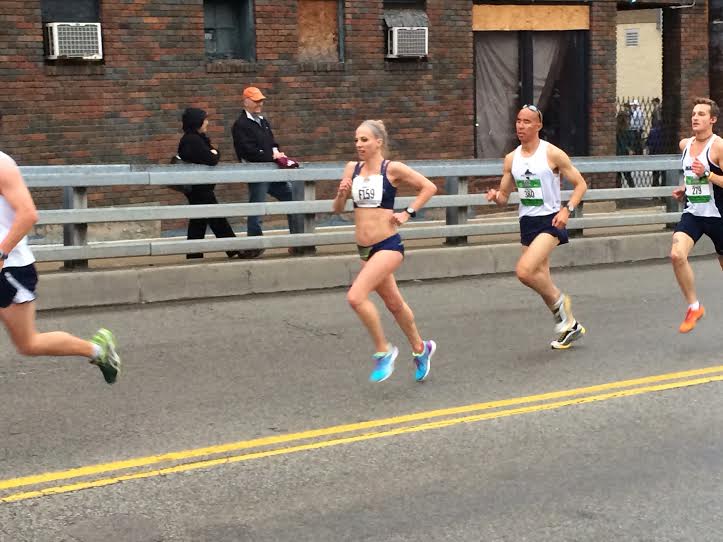We are coming up on a week until race day for the Pittsburgh Marathon! I wanted to share a bit about my nutrition plan (especially race week nutrition) now so it’s fresh in your mind for next week.
If you’ve known me for awhile now, you know I’ve had many longer races (beginning in 2011) spoiled by stomach problems. It’s very soul-crushing to put a lot of time and energy into a race and come up short on a goal because of porta-potty problems. I’ve been working on little solutions and while I don’t want to jinx myself, I think I have quite a bit figured out. I haven’t had any stomach issues in races in 2015 so I thought I’d share a bit about my normal diet and then tell you about how that changes during race week.
I found out I was lactose intolerant during my sophomore year in college, but I continued consuming most dairy (except milk) because cheese/yogurt/ice cream/etc are delicious and I could deal with some bloating most of the time. When I started running seriously about 10 years later, I began realizing my body couldn’t handle long or intense runs with dairy in my system. I also found out through elimination dieting while breastfeeding that both of my babies were miserable and fussy when I consumed dairy. This is the very short version of many years of struggling with my love of these foods and my body’s hatred for them. I have found a happy place where I don’t have dairy MOST of the time, and don’t usually miss it. I will sometimes have quesadillas or pizza with real cheese and of course ice cream. I just avoid these foods 2 days before workouts, and a week before a big race. But most of the time I just avoid them completely because I don’t usually want them. If you would have asked me even 2 years ago if my life could ever be this dairy-free, I would tell you no. After the initial mourning period (of many months), it was actually pretty easy.
A typical food day for me includes a lot of calories. I’m a 60-80 mile per week runner, a hands-on active parent of 2, a person who chooses to walk over driving on most occasions, and a breastfeeding mother (until I weaned my son about 2 weeks ago). You can imagine the thousands of calories I need to support my activity level. I try to eat the way many people do – mostly from the earth, minimally processed foods. However, a typical day finds me grabbing convenience foods or cooking frozen dinners.
A typical day might look like this:
Breakfast within minutes of waking. 99% of the time I eat toast with some type of nut butter, chia seeds, and banana. I drink about 30 oz of water and a mug of black coffee. This is the meal that never changes.
After my run I will have either a Vega recovery drink, a picky bar, or another banana with nut butter.
I usually also snack on something junk-foody if it’s there. This would be candy from the latest holiday or a pastry from the bakery next door. If I don’t do this in the morning, I might do it in the afternoon.
For lunch I eat something like hummus and crackers and a few eggs on bread with avocado. Or I’ll have a veggie burger with avocado. I usually eat 1-2 avocados a day.
In the afternoon, I usually have a few more bananas. They are the easiest fruit in my opinion. No washing, very portable, delicious! I also eat whatever other fruit my kids are into at the time. I might also have dry cereal, crackers, nuts/trail mix.
My goal for dinner is always something with lots of veggies, a grain, some beans or tofu, occasionally some fish or meat. On good days, I accomplish this goal. Many days, dinner is something frozen from Trader Joes (insert anything in their frozen section here). Family favorites are probably their pizzas (they have a good dairy free roasted vegetable one), or fish sticks and sweet potato fries, mini frozen tacos, and spanakopita. Usually by the end of the day the kids are feeling a little wild and my husband gets home late and prepping my perfect little meal just doesn’t happen. We also go out to dinner fairly often.

When we go out for dinner, I TRY to pick something healthy. If I’m lacking in vegetables, I order a big salad. I love a good veggie burrito as well! I’d say about half of the time I end up getting a sandwich and fries or tots. I’m obviously not a food photographer!
Before bed I have either some kind of dessert or another banana or two with nut butter. Yes, I eat 4-6 bananas every single day!
The most important part of this post in my opinion is what I do during race week! I’ve been feeling really good about my pre-race meals and hope I can help some of you who may be having tummy troubles. First of all, I completely avoid dairy the entire week before my race. Besides that, I don’t change much at the beginning of the week. I start eating fewer vegetables and fruits about 4 days out from the race and eat more pretzels and crackers.
I think the biggest change I’ve made is my diet the day before the race. As I looked over my diet, I realized I consume a lot of calories and my body has a lot to process. I thought maybe I could change the timing of my calories so my body would get everything it needs but still have time to work everything through before race time. This is the plan that has been working for me:
On race-day-eve in the morning I eat my normal breakfast and recovery foods immediately after my run. Then I eat a very large lunch. I like a huge omelet with just a few veggies (no cheese!), potatoes, and toast. I drink a good amount of water as usual. In the afternoon I snack on some pretzels or bread. Then at dinnertime, I eat a much smaller meal than normal. I make sure I’m content but not full/stuffed. I have found this combo – a side order of rice, 2 spoonfuls of black beans (this is totally random), and 2-3 flour tortillas – to work great. It’s the most boring and smallest meal I eat, but worth it to feel good the next day.
As far as what to do the day of the race, you should do whatever you practiced! Here’s what I do, and it’s still a work in progress!
On race morning I eat a plain or salt bagel or piece of cinnamon raisin bread, depending on what I can find, topped with a bit of nut butter 3 hours before the race. I drink no more than 6 ounces of coffee, and maybe 30-40 oz of water in the few hours leading up to the race. With 30 minutes to go, I drink a Vega pre-workout drink. Then with 10-20 minutes to go I take a vanilla Gu.
During a half and full marathon, I take water or the electrolyte drink provided on the course at every stop. During a half I will take a swallow of gel (most of the time) around mile 7, about 40 minutes into the race. During a full, I will do the same as the half with fluids every time provided and a bit of gel every 6-8 miles.
Hope this helps someone and feel free to ask me any questions!



